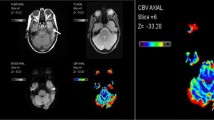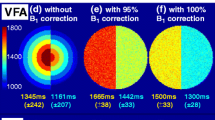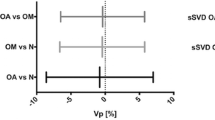Abstract
Purpose:
To assess if intratumoral blood circulation parameters from dynamic susceptibility contrast (DSC) MRI and dynamic CT deliver comparable results and to compare tumor-related changes in regional cerebral blood flow (rCBF) and regional cerebral blood volume (rCBV) with arterial, intratumoral, and venous transition detected with digital subtraction angiography (DSA).
Patients and Methods:
Ten patients with cerebral gliomas were prospectively studied with DSC-MRI, dynamic CT and DSA. Tumor areas were segmented and perfusion maps for rCBF, rCBV, and mean transit time (MTT) were computed from DSC-MRI and dynamic CT. Arterial circulation time (ACT), intermediate circulation time (ICT), and venous appearance time (VAT) were measured with DSA. Asymmetry indices (AIs) were calculated for MRI- and CT-based perfusion values, for ICT and VAT and compared among each other.
Results:
DSC-MRI and dynamic CT yielded comparable AI values for rCBF (MRI: 39.5 ± 20.4, CT: 36.0 ± 17.9, Pearson's correlation r2 = 0.91) and rCBV (MRI: 44.6 ± 20.9 vs. CT: 40.9 ± 16.3, r2 = 0.84). The MTT AI (MRI: –4.7 ± 11.2 vs. CT: –0.5 ± 10.4, r2 = 0.47) showed only a weak correlation. ICT correlated with rCBV (ICT: 38.4 ± 14.7, r2 = 0.59, and dynamic CT: r2 = 0.81) and VAT with rCBF (VAT: 31.7 ± 17.6, r2 = 0.73, and dynamic CT: r2 = 0.87), but not with MTT.
Conclusion:
CT and MRI methods provide consistent information about tumor vascularity of cerebral gliomas in accordance with DSA.
Zusammenfassung
Ziel:
Vergleichsstudie zur Perfusionsmessung mittels CT- und MR-Perfusion bei Hirntumoren mit der Fragestellung, inwieweit beide Schnittbildverfahren bezüglich der Parameter regionaler zerebraler Blufluss (rCBF), regionales zerebrales Blutvolumen (rCBV) und mittlere Transitzeit (MTT) vergleichbare Ergebnisse zeigen. Die Ergebnisse werden mit den dynamischen Untersuchungsergebnissen der digitalen Subtraktionsangiographie (DSA) verglichen.
Patienten und Methodik:
Zehn Patienten mit hirneigenen Tumoren wurden prospektiv mittels MR-Perfusion, CT-Perfusion und DSA untersucht. Die Tumoren wurden segmentiert. In den segmentierten Arealen wurden rCBF, rCBV und MTT aus den Daten beider Modalitäten berechnet. Die arterielle Zirkulationszeit (ACT), intermediäre Zirkulationszeit (ICT) und venöse Anflutungszeit (VAT) wurden mittels DSA bestimmt. Regionenbasierte Asymmetrieindizes wurden für die CT- und MR-Perfusion, für ICT und VAT berechnet und verglichen.
Ergebnisse:
MR- und CT-Perfusion lieferten vergleichbare Ergebnisse für rCBF (MRT: 39,5 ± 20,4, CT: 36,0 ± 17,9, Pearson-Korrelation r2 = 0,91) und rCBV (MRT: 44,6 ± 20,9 vs. CT: 40,9 ± 16,3, r2 = 0,84). Der Asymmetrieindex für MTT (MRT: –4,7 ± 11,2 vs. CT: –0,5 ± 10,4, r2 = 0,47) zeigte lediglich eine schwache Korrelation zwischen den Modalitäten. Die ICT korrelierte mit dem rCBV (ICT: 38,4 ± 14,7, r2 = 0,59, CT: r2 = 0,81) und die VAT mit dem CBF (VAT: 31,7 ± 17,6, r2 = 0,73, CT: r2 = 0,87), jedoch nicht mit der MTT.
Schlussfolgerung:
Die Perfusionsmessung intrazerebraler Tumoren mittels CT und MRT liefert vergleichbare Ergebnisse, auch in Übereinstimmung mit der DSA.
Similar content being viewed by others
Author information
Authors and Affiliations
Corresponding author
Rights and permissions
About this article
Cite this article
Wiest, ., Schaer, R., Reinert, M.H. et al. Vascular Dynamics of Cerebral Gliomas Investigated with Selective Catheter Angiography, Perfusion CT and MRI. Clin Neuroradiol 18, 98–106 (2008). https://doi.org/10.1007/s00062-008-8011-y
Received:
Accepted:
Issue Date:
DOI: https://doi.org/10.1007/s00062-008-8011-y




